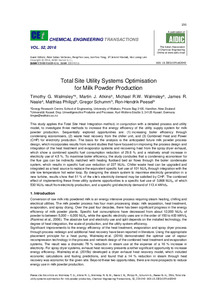Datum
2016Autor
Walmsley, Timothy GordonAtkins, Martin JohnWalmsley, Michael R. W.Neale, James R.Philipp, MatthiasSchumm, GregorPeesel, Ron-HendrikSchlagwort
620 Ingenieurwissenschaften EnergieeffizienzTrockenmilchProduktionssystemProzessmanagementMetadata
Zur Langanzeige
Aufsatz

Total Site Utility Systems Optimisation for Milk Powder Production
Zusammenfassung
This study applies the Total Site Heat Integration method, in conjunction with a detailed process and utility model, to investigate three methods to increase the energy efficiency of the utility supply system for milk powder production. Sequentially explored opportunities are: (1) increasing boiler efficiency through condensing economisers, (2) waste heat recovery from the chiller unit, and (3) Combined Heat and Power (CHP) for electricity production. The basis for the analysis is the anticipated future milk powder process design, which incorporates results from recent studies that have focused on improving the process design and integration of the heat treatment and evaporator systems and recovering heat from the spray dryer exhaust, which show a combined specific fuel consumption reduction of 29.6 % and a relatively small increase in electricity use of 4.5 %. To maximise boiler efficiency, the study concludes that a condensing economiser for the flue gas can be indirectly matched with heating fluidised bed air flows through the boiler condensate system, which results in specific fuel use reduction of 227 MJ/tp. Chiller waste heat can be upgraded and integrated as a heat source to replace the equivalent specific fuel use of 101 MJ/tp through integration with the site low temperature hot water loop. By designing the steam system to maximise electricity generation in a new turbine, results show that 51 % of the site’s electricity demand may be satisfied by CHP. The combined effect of implementing these three utility systems opportunities is a specific fuel use of 3,868 MJ/tp, of which 530 MJ/tp result from electricity production, and a specific grid electricity demand of 113.4 kWh/tp.
Zitierform
In: Chemical engineering transactions (CEt) Volume 52 (2016) , S. 235-240 ; EISSN 2283-9216Zitieren
@article{doi:10.17170/kobra-202012092474,
author={Walmsley, Timothy Gordon and Atkins, Martin John and Walmsley, Michael R. W. and Neale, James R. and Philipp, Matthias and Schumm, Gregor and Peesel, Ron-Hendrik},
title={Total Site Utility Systems Optimisation for Milk Powder Production},
journal={Chemical engineering transactions (CEt)},
year={2016}
}
0500 Oax
0501 Text $btxt$2rdacontent
0502 Computermedien $bc$2rdacarrier
1100 2016$n2016
1500 1/eng
2050 ##0##http://hdl.handle.net/123456789/12375
3000 Walmsley, Timothy Gordon
3010 Atkins, Martin John
3010 Walmsley, Michael R. W.
3010 Neale, James R.
3010 Philipp, Matthias
3010 Schumm, Gregor
3010 Peesel, Ron-Hendrik
4000 Total Site Utility Systems Optimisation for Milk Powder Production / Walmsley, Timothy Gordon
4030
4060 Online-Ressource
4085 ##0##=u http://nbn-resolving.de/http://hdl.handle.net/123456789/12375=x R
4204 \$dAufsatz
4170
5550 {{Energieeffizienz}}
5550 {{Trockenmilch}}
5550 {{Produktionssystem}}
5550 {{Prozessmanagement}}
7136 ##0##http://hdl.handle.net/123456789/12375
<resource xsi:schemaLocation="http://datacite.org/schema/kernel-2.2 http://schema.datacite.org/meta/kernel-2.2/metadata.xsd"> 2020-12-23T13:32:21Z 2020-12-23T13:32:21Z 2016 doi:10.17170/kobra-202012092474 http://hdl.handle.net/123456789/12375 eng Urheberrechtlich geschützt https://rightsstatements.org/page/InC/1.0/ 620 Total Site Utility Systems Optimisation for Milk Powder Production Aufsatz This study applies the Total Site Heat Integration method, in conjunction with a detailed process and utility model, to investigate three methods to increase the energy efficiency of the utility supply system for milk powder production. Sequentially explored opportunities are: (1) increasing boiler efficiency through condensing economisers, (2) waste heat recovery from the chiller unit, and (3) Combined Heat and Power (CHP) for electricity production. The basis for the analysis is the anticipated future milk powder process design, which incorporates results from recent studies that have focused on improving the process design and integration of the heat treatment and evaporator systems and recovering heat from the spray dryer exhaust, which show a combined specific fuel consumption reduction of 29.6 % and a relatively small increase in electricity use of 4.5 %. To maximise boiler efficiency, the study concludes that a condensing economiser for the flue gas can be indirectly matched with heating fluidised bed air flows through the boiler condensate system, which results in specific fuel use reduction of 227 MJ/tp. Chiller waste heat can be upgraded and integrated as a heat source to replace the equivalent specific fuel use of 101 MJ/tp through integration with the site low temperature hot water loop. By designing the steam system to maximise electricity generation in a new turbine, results show that 51 % of the site’s electricity demand may be satisfied by CHP. The combined effect of implementing these three utility systems opportunities is a specific fuel use of 3,868 MJ/tp, of which 530 MJ/tp result from electricity production, and a specific grid electricity demand of 113.4 kWh/tp. open access Walmsley, Timothy Gordon Atkins, Martin John Walmsley, Michael R. W. Neale, James R. Philipp, Matthias Schumm, Gregor Peesel, Ron-Hendrik doi:10.3303/CET1652040 Energieeffizienz Trockenmilch Produktionssystem Prozessmanagement publishedVersion EISSN 2283-9216 Chemical engineering transactions (CEt) 235-240 Volume 52 false </resource>
Die folgenden Lizenzbestimmungen sind mit dieser Ressource verbunden:
Urheberrechtlich geschützt

